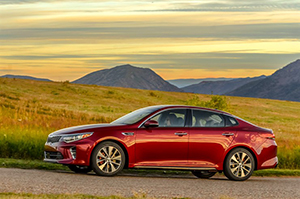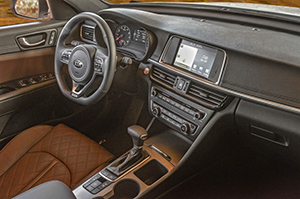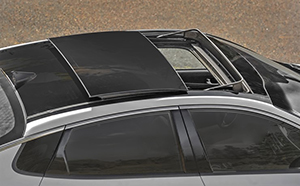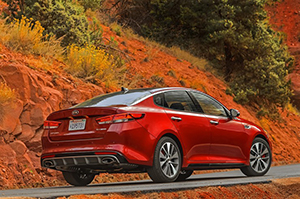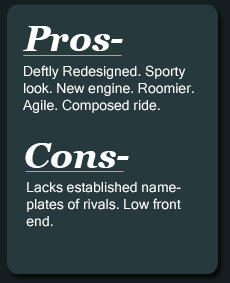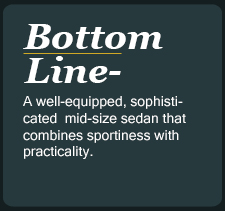2016 Kia Optima
The 2016 Kia Optima gets a
racier look, better interior and a new engine.
Prices: $21,990-$35,890
Automakers are breaking the bank with crossover and medium-size SUVs,
but know that they need a solid mid-size sedan to be considered a
full-line outfit.
And so we have the redesigned 2016 mid-size Optima sedan from Kia,
which some may remember as being a producer of dull economy cars.
Optima rivals, such as the Honda Accord, Nissan Altima and Ford Fusion,
have more familiar names and shinier reputations.
The new fun-to-drive Optima, however, is a worthy competitor to
established, popular mid-size sedans. Its new chassis is shared with
Hyundai's Sonata, which is a good starting point. It has a longer
wheelbase than its predecessor, at 110.4 inches, and width has been
increased 1.2 inches to 73.2 inches. That allows a roomier interior for
four tall adults. Long doors with big handles make it easy to get in
and out.
Trunk room is impressive, increased to 15.9 cubic feet, and rear
seatbacks fold flat to provide crossover-vehicle-style cargo room.
But it's the styling of the longer, wider and slightly taller 2016
Optima that likely will first attract many folks. An
aggressive front end "pulls" body sheet metal taut over the wheel
arches, and swept-back headlights reach deeply into the fenders.
While it's a four-door sedan, the Optima has a coupe-like roofline that
adds to the car's sporty look without robbing rear headroom.
Eye-catching dual chromed exhaust tips help complete the sporty look. I
like the new deep red paint that gains depth from the use of aluminum
pigments.
The roomier interior has more soft-touch materials throughout.
Attractive stitching is along the dashboard and doors, and the cabin
has been simplified with a cleaner, more unified design.
The redesigned center console has easily reached cupholders and creates
a greater sense of space. The number of functional keys and buttons
have been reduced and grouped to improve ergonomics. A deep console
storage bin, storage pockets in all doors and a large glove compartment
provide a decent amount of interior cargo space.
The interior is quieter partly because engine mounts, body panels and
wheels are stiffer, reducing vibration and engine and road noise.
Kia's UVO touch-screen infotainment system has Apple CarPlay and
Android Auto, letting you operate select apps from iPhone and Android
phones through a touch screen.
Redesigned front seats are supportive and have a stiffer frame to
reduce vibration. Importantly, backlit gauges are easy to read in
sunlight.
Optima provides a fairly wide range of models, with list prices ranging
from $21,990 to $35,890. Offered are LX, EX, SX and SXL models.
There's a new 1.6-liter turbocharged four-cylinder that develops 178
horsepower and a stout 195 pound-feet of torque at just 1,500 r.p.m. It
works with a seven-speed dual-clutch automatic transmission--a first
for Kia.
Two carryover engines are a turbocharged 2-liter four-cylinder with 245
horsepower and 260 pound-feet of torque and a 2.4-liter four-cylinder
with 185 horsepower and 178 pound-feet of torque. My test car had the
2-liter turbo engine.
Estimated fuel economy of this approximately 3,300-pound car ranges
from 22 miles per gallon in the city and 32 on highways for the 2-liter
turbo to an impressive 28 miles per gallon in the city and 39 on
highways for the new 1.6-liter turbo engine. The "2.4" delivers 24 and
35.
The carryover engines work with a 6-speed automatic transmission. Kia
says they can use 87- (or higher) octane gasoline.
I'd opt for the smooth, quiet 2-liter turbo, which provides fast
acceleration off the line and swift merging and passing in fast
traffic. The tachometer needle doesn't even reach the 2,000 r.p.m.
mark at 65 m.p.h., showing that the engine is fairly loafing
at that speed.
I tested the $29,690 SX Turbo model. Its features include
dual-zone automatic climate control, pushbutton start, power driver's
seat with memory, heated front seats with leather trim, navigation
system with an 8-inch rear-camera display and 4.2-inch color TFT-LCD
meter cluster.
Nobody knows for sure when the completely driverless car will go on
sale, but the new Optima's available Autonomous Emergency Braking
system will bring the car to a complete stop under certain
conditions to avoid a collision.
Adding to my test car's price was a $2,700 SXT Launch Edition package
with items in addition to, or in place of, my test car's standard
features. They included a panoramic sunroof, Harman Kardon premium
surround sound system, power front passenger's seat, heated outboard
rear seat cushions, blind-spot detection system, rear cross-traffic
alert and rear parking assist system.
That package seems worth the money, although I'm no fan of sunroofs.
My test car's steering was fast and precise, with decent road feel. A
modified suspension and 18-inch alloy wheels (up from standard 16-inch
alloys) helped make the car agile. It has a nicely composed ride. For
one thing, moving suspension points outward optimizes suspension
geometry for a smoother ride over uneven pavement.
The chassis is lighter and stiffer, resulting in nearly 60 percent more
torsional rigidity than the previous model. This contributes to
improved steering response, high-speed stability and handling.
Traction and electronic stability control systems, along with Vehicle
Stability Management, help out if a driver gets in over his head. The
anti-lock brakes stopped the car quickly and surely, with good pedal
feel.
Kia looks like it has a winner with the new Optima, which should
further help the automaker erase its rapidly disappearing old stodgy
image.


